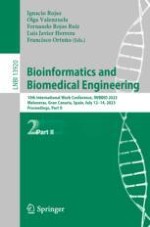2023 | OriginalPaper | Buchkapitel
Degree-Normalization Improves Random-Walk-Based Embedding Accuracy in PPI Graphs
verfasst von : Luca Cappelletti, Stefano Taverni, Tommaso Fontana, Marcin P. Joachimiak, Justin Reese, Peter Robinson, Elena Casiraghi, Giorgio Valentini
Erschienen in: Bioinformatics and Biomedical Engineering
Verlag: Springer Nature Switzerland
Aktivieren Sie unsere intelligente Suche, um passende Fachinhalte oder Patente zu finden.
Wählen Sie Textabschnitte aus um mit Künstlicher Intelligenz passenden Patente zu finden. powered by
Markieren Sie Textabschnitte, um KI-gestützt weitere passende Inhalte zu finden. powered by
